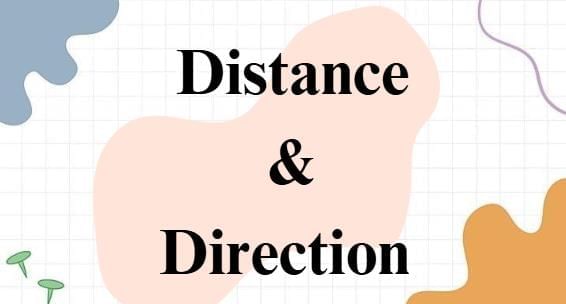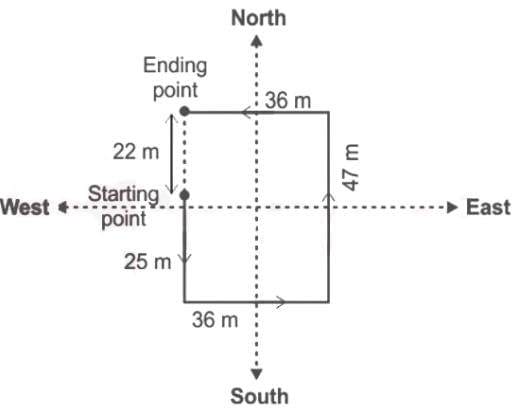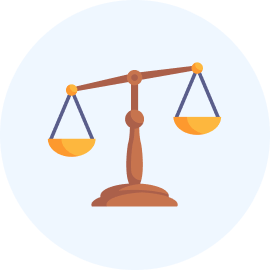CLAT Exam > CLAT Notes > Logical Reasoning for CLAT > Practice Questions: Distance & Direction- 1
Practice Questions: Distance & Direction- 1 | Logical Reasoning for CLAT PDF Download

Q1: Ram is facing west. He took a right turn and walks 20 m. He then again turns right and walks for 10 m. From there he walks 10 m to north and then 10 m towards west. In which direction is he from the original position?
(a) North-East
(b) North-West
(c) South-East
(d) South-West
Ans: (a)
Ram is facing west and takes a right turn and walks for 20km towards north. He again took a right turn and walk for 10 km towards east. He walks 10 km towards north and then 10 km towards west. So, with respect to starting point R is in North-East direction.
Q2: A travels 35 km towards west, takes a right turn and travels 50 km more. Next, she takes another right turn and travels 35km in that direction. How far is she from her original position?
(a) 75km
(b) 45km
(c) 90km
(d) 50km
Ans: (d)
A walks 35 km in the west direction and took a right turn and walks for 50 km. He again takes a right turn and walk for 35 km. He stops there. As we can see in the figure, the distance between starting point and the end point will be 50 km.
Q3: P ran 40 m east, then turned left and ran 20 m and then turned to right and ran 18 m and turned to left, ran 24 m and finally turned to left and ran 12 m. Now he is running towards which direction.
(a) North
(b) South
(c) East
(d) West
Ans: (d)
P was initially running 40 km in east direction. Then, P took a left turn and ran for 20km in the North direction. Again after taking a right turn P ran for 18 km in east direction. P took a left turn and ran 24km in North direction and took a right turn and ran for 12 km in the west direction.
So, P is finally running in the west direction.
Q4: Amit first goes in South direction, then he turns towards left and travel for some distance. After that he turns right and moves certain distance. At last he turns he left and travels again for some distance. Now, in which direction is he moving?
A. South
B. West
C. North
D. East
Ans: (d)
He starts by going South.
He then turns left. Facing South, left points him East, so he moves eastward.
Next he turns right. Facing East, right points him South, so he moves southward.
Finally he turns left. Facing South again, left points him East, so he moves eastward once more.
At the end of this sequence, Amit is moving East.
Q5: Two buses start from the opposite points of a main road, 150 kms apart. The first bus runs for 25 kms and takes a right turn and then runs for 15 kms. It then turns left and runs for another 25 kms and then heads straight back to the main road. In the meantime, due to a minor breakdown, the other bus has run only 35 kms along the main road. What is the distance between the two buses at this point?
A. 65 kms
B. 75 kms
C. 40 kms
D. 30 kms
Ans: (a)
Place the main road on an east–west axis. Let point A be at x = 0 and point B at x = 150.1. First bus’s path
From A it goes 25 km east to (25, 0).
Turns right (south) and goes 15 km to (25, –15).
Turns left (back east) and goes 25 km to (50, –15).
Then returns north 15 km to rejoin the main road at (50, 0).
2. Second bus’s path
From B at (150, 0), it travels 35 km toward A, ending at (115, 0).
3. Both are now on the main road at x = 50 and x = 115, respectively.
4. Distance between them = 115 – 50 = 65 kms.
Q6: Roshan, Vaibhav, Vinay and Sumit are playing cards. Roshan and Vaibhav are partners. Sumit faces towards North. If Roshan faces towards West, then who faces towards South?
A. Vinay
B. Vaibhav
C. Sumit
D. Roshan
Ans: (a)
In four-player card games with fixed partners, partners sit opposite each other around the table. When a player “faces North,” that player is seated on the South side facing inward; when a player “faces West,” they sit on the East side facing inward.
Sumit faces North ⇒ Sumit sits on the South side facing North.
Roshan faces West ⇒ Roshan sits on the East side facing West.
Roshan’s partner Vaibhav must sit opposite Roshan ⇒ Vaibhav sits on the West side facing East.
The only remaining seat is the North side, facing South ⇒ that seat goes to Vinay.
Therefore, Vinay faces South.
Q7: One morning just after sunrise, Suraj was standing facing a pole. The shadow of the pole fell exactly to his right. Which direction was Suraj facing?
A. West
B. South
C. East
D. North
Ans: (b)
Just after sunrise, the Sun is in the East, so shadows point toward the West.
Suraj’s shadow falls to his right, so his right-hand side must be West.
Facing so that West is on his right means he is facing South.
Q8: Isha starts from Point A and drives 5 km towards the East. She then takes a left turn, drives 7 km, turns left and drives 9 km. She then takes a left turn and drives 12 km. She takes a final left turn, drives 4 km and stops at Point P. How far (shortest distance) and towards which direction should she drive in order to reach Point A again? (All turns are 90-degree turns unless specified)
A. 4 km to the East
B. 3 km to the West
C. 5 km to the North
D. 2 km to the North
Ans: (c)
Net displacement:
- East: 5 km - 9 km + 4 km = 0 km
- North: 7 km - 12 km + 4 km = -5 km (or 5 km South)
To reach Point A from P:
- Distance: 5 km
- Direction: North
Isha should drive 5 km towards the North to reach Point A again.
Q9: Gaurav exits from the backdoor of his north-facing house and walks 25 m straight, then he takes a left turn and walks 36 m, then he takes left and walks 47 m. He turns left again and walks 36 m. How far and in which direction is he from his house now?
A. 22 m, North
B. 11 m, North
C. 22 m, South
D. 11 m, South
Ans: (a)
Gaurav exits from the backdoor of his north-facing house means Gaurav starts to walk south side.
1. Gaurav walks south 25 m straight
2. then he takes a left turn and walks 36 m
3. then he turns left and walks 47 m.
4. He turns left again and walks 36 m.
Q10: Varun starts from Point A and drives 37 km towards the north. He then takes a right turn, drives 39 km, turns right and drives 40 km. He then takes a right turn and drives 45 km. He takes a final right turn, drives 3 km and stops at Point P. How far (shortest distance) and towards which direction should he drive in order to reach Point A again? (All turns are 90-degree turns only unless specified)
A. 6 km to the east
B. 5 km to the west
C. 5 km to the east
D. 6 km to the west
Ans: (a)
Varun starts from Point A and drives 37 km towards the north. He then takes a right turn, drives 39 km, turns right and drives 40 km. He then takes a right turn and drives 45 km. He takes a final right turn, drives 3 km and stops at Point P.Thus, to reach Point A Varun has to drive 6 km to the east.
The document Practice Questions: Distance & Direction- 1 | Logical Reasoning for CLAT is a part of the CLAT Course Logical Reasoning for CLAT.
All you need of CLAT at this link: CLAT
|
38 videos|128 docs|75 tests
|
FAQs on Practice Questions: Distance & Direction- 1 - Logical Reasoning for CLAT
| 1. What is the significance of distance and direction in CLAT preparation? |  |
Ans. Understanding distance and direction is crucial for logical reasoning sections in CLAT. These concepts help in solving problems related to the movement of objects in space, which can include identifying relative positions, navigating through diagrams, and interpreting data that involve directional movement. Mastering these skills enhances critical thinking and analytical abilities essential for success in the exam.
| 2. How can I improve my skills in solving distance and direction problems? |  |
Ans. To improve your skills in distance and direction problems, practice regularly with a variety of questions. Begin with basic problems to understand the fundamental concepts, and gradually move on to more complex scenarios. Use diagrams to visualize movements and relationships between points. Additionally, taking mock tests and reviewing previous years’ questions can help familiarize you with the exam format and question types.
| 3. What types of questions can I expect related to distance and direction in the CLAT exam? |  |
Ans. In the CLAT exam, you can expect questions that involve calculating distances between points, determining the direction of movement, and solving problems related to the relative position of objects. Questions may include scenarios where you need to interpret or analyze statements given in the form of directions or movements, often requiring you to draw conclusions based on the information provided.
| 4. Are there any common mistakes to avoid when solving distance and direction questions? |  |
Ans. Yes, common mistakes include misinterpreting direction indicators (like north, south, east, west), neglecting to draw diagrams for better visualization, and making calculation errors while determining distances. It’s also important to carefully read the questions to avoid assumptions that can lead to incorrect answers. Taking time to double-check your work can help minimize these errors.
| 5. How can I effectively manage my time while solving distance and direction questions in the exam? |  |
Ans. Effective time management can be achieved by practicing under timed conditions. Set a specific time limit for each question during practice sessions to simulate exam conditions. Prioritize questions based on your strengths and ensure to allocate time for reviewing your answers. If a question seems too challenging, it may be wise to move on and return to it later, ensuring that you maximize your overall score within the time constraints.
Related Searches






















